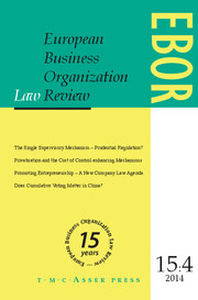No CrossRef data available.
Article contents
Economic Analysis, Anti-trust Law and the Oligopoly Problem
Published online by Cambridge University Press: 17 February 2009
Extract
Competition is socially desirable because, in general, in a competitive environment, firms' desire to maximize their profits will force them, in the long run, not only to become as efficient as possible but also to lower their prices to the level of their average (economic) costs.
- Type
- Articles
- Information
- Copyright
- Copyright © T.M.C. Asser Press and the Authors 2000
References
1 Cournot, , Researches into the Mathematical Principles of the Theory of Wealth, (Homewood Illinois, Richard D. Irwin 1963) (trans. Bacon).Google Scholar
2 Compte, Jenny, , AND Rey, , Capacity Constraints, Mergers and Collusions (forthcoming), available in mimeograph form (1998).Google Scholar
3 Cases 89, 104, 114, 116-117, 125-129/85 Ahlström Osakeyhtiöv. Commission [1988] ECR 5193.
4 Goyder, , EC Competition Law, 3rd edn., (Oxford, Clarendon 1998) p. 100Google Scholar: “An important element in establishing the existence of concerted practices is some form of contact between the parties, which must involve an intentional communication of some information between them either directly or through an intermediary. There must be some positive intention on the part of one party to direct the information to the other, or at least to launch it into the relevant area where the other is likely to receive it. It is also essential for the Commission to be able to show that the party receiving the information is aware of having done so, not accidentally but as a target. Such giving and receiving of information clearly goes beyond mutual awareness by competitors that the terms which they quote to their customers will subsequently become known to their competitors, who will naturally make use of this knowledge in their own pricing and other competitive strategies.”
5 Matsushita Electrical Industrial Co. v. Zenith Radio Corp., 475 US 574, 588 (1986).
6 US contribution to Oligopoly, Series Round Tables on Competition Policy, No. 25 (1999).
7 Case T-34/92 Fiatagri and New Holland v. Commission, [1994] ECR II-905.
8 See the New Zealand contribution to Oligopoly, op. cit. n. 6.
9 Case IV/M.619 Gencor/Lonrho, [1996] 4 CMLR 742, on appeal case T-102/96 Gencor v. Commission (only procedural issues), [1997] 5 CMLR 290.
10 Case 27/76 United Brands v. Commission (Chiquita Bananas), [1978] ECR 207.
11 Quoted in the Australian contribution to Oligopoly, op. cit. n. 6.
12 US contribution to Oligopoly, op. cit. n. 6.
13 The « Merger Regulation », Council Regulation 4064/89 of 21 December 1989, OJ [1989] L 395/1, on the control of concentrations between undertakings.
14 Cases C-65/94 and 30/95 France v. Commission (Kali and Salz (No. 2)), [1998] ECR 1-1375, recitals 152-178.
15 See the United Kingdom contribution to Oligopoly, op. cit. n. 6.
16 The subsequent development is based on research by Compte et al., op. cit. n. 2. Not all the theoretical developments have been reproduced here; the results are summarized.
17 Recital 35: « For the reasons set out above, the assessment of the compatibility of the proposed merger is made on the basis of a separate French market for bottled waters (hereinafter referred to as ‘bottled water’) which is composed of still waters and sparkling waters. The focus of the assessment will mainly lie on the segment of still waters because this segment represents approximately 84% of the total bottled water market in volume terms and because no material change occurs in the segment of sparkling waters where Nestle1 itself has only a small activity in flavoured sparkling waters.»
18 Case IV/M 190 Nestlé/Perrier, Commission Decision 92/553 of 22 July 1992, OJ [1992] L 356/1; [1993] 4 CMLR M17.
19 Due to space constraints, the method used to estimate the market shares and capacities of the main suppliers is not detailed here and only the results are mentioned. A note giving the details of the method used can be provided by the author upon request. The methodology and results are detailed in Compte, Jenny and Rey, supra n. 2.


